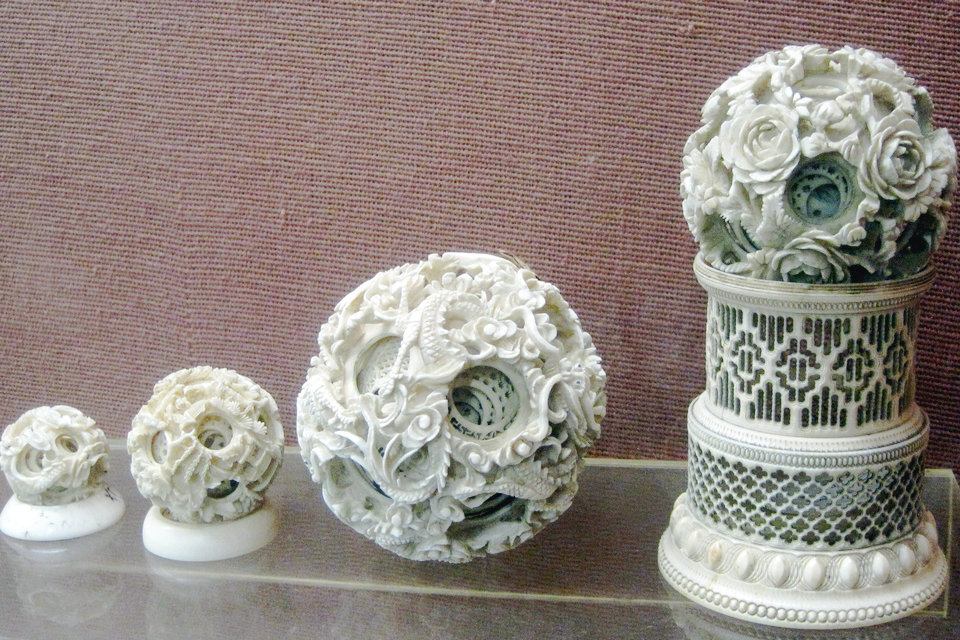Ivory Carvings Gallery, Salar Jung Museum


The Salar Jung Museum has a good collection of ivory carvings from different parts of the world. The collection of ivory gives an excellent idea of ivory as a medium of plastic art. The chessmen, chausar sets of Ivory in the collection form an interesting group. Amongst the objects of European ivory carvings, a set of our ivory chairs said to have been presented by Louis XVI of France to Tipu Sultan of Mysore deserves special mention. The collection of carved paper cutters also forms a splendid group. The large size paper cutter catches the attention of the onlooker. Apart from the above, there are also procession scenes, delicately carved boxes, flywhisks, figures of animals and bedsteads.
Salar Jung Museum:
The Salar Jung Museum is an art museum located at Darushifa, on the southern bank of the Musi River in the city of Hyderabad, Telangana, India. It is one of the three National Museums of India. It has a collection of sculptures, paintings, carvings, textiles, manuscripts, ceramics, metallic artefacts, carpets, clocks, and furniture from Japan, China, Burma, Nepal, India, Persia, Egypt, Europe, and North America. The museum’s collection was sourced from the property of the Salar Jung family. It is one of the largest museums in the world.
The Salar Jung Museum of Hyderabad is a repository of the artistic achievements of diverse European, Asian and Far Eastern countries of the world. The major portion of this collection was acquired by Nawab Mir Yousuf Ali Khan popularly known as Salar Jung III. The zeal for acquiring art objects continued as a family tradition for three generations of Salar Jungs. In 1914, Salar Jung III, after having relinquished the post of Prime Minister to H.E.H., the Nizam VII, Nawab Mir Osman Ali Khan, devoted rest of his entire life in collecting and enriching the treasures of art and literature till he lived. The precious and rare art objects collected by him for a period of over forty years, find place in the portals of the Salar Jung Museum, as rare to very rare pieces of art.
After the demise of Salar Jung-III, the vast collection of precious art objects and his Library which were housed in “Dewan-Deodi” the ancestral palace of the Salar Jungs, the desirability of organizing a Museum out of the Nawab’s collection dawned quite soon and Sri M.K. Velodi, the then Chief Civil Administrator of the Hyderabad State approached Dr.James Cousins a well known art critic, to organize the various objects of art and curios which were lying scattered in different palaces of Salar Jung III to form a Museum.
With a view to perpetuate the name of Salar Jung as a world renowned art connoisseur, the Salar Jung Museum was brought in to existence and was opened to the public by Pandit Jawaharlal Nehru, the then Prime Minister of India on 16th December, 1951.
However, the administration of the Museum continued to be vested in the Salar Jung Estate Committee till 1958. Thereafter, the heirs of Salar Jung Bahadur graciously agreed to donate the entire collection to the Government of India through a Compromise Deed based on a High Court Decree on 26th December l958. The Museum continued to be administered directly by the Government of India till 1961. Through an Act of Parliament (Act of 26 of 1961) the Salar Jung Museum with its Library was declared to be an Institution of National Importance. The administration was entrusted to an Autonomous Board of Trustees with the Governor of Andhra Pradesh as its Ex-officio Chairman and ten other members representing the Government of India, the State of Andhra Pradesh, Osmania University and one from the family of Salar Jungs.